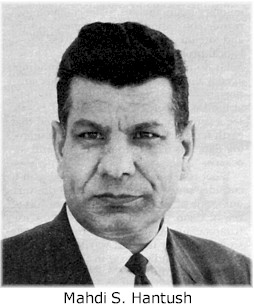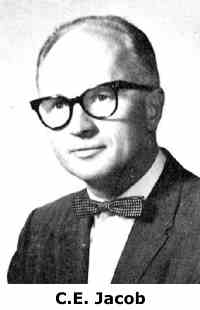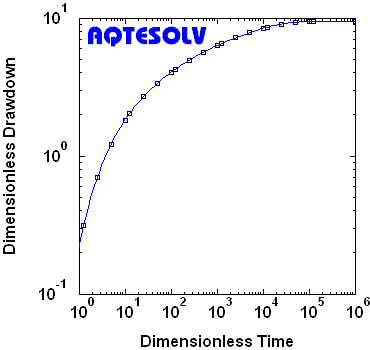Hantush and Jacob r/B Solution for Leaky Confined Aquifers
- Assumptions
- Equations
- Data requirements
- Solution options
- Estimated parameters
- Curve matching tips
- Benchmark
- References
Related Solution Methods
Additional Topics

 A mathematical solution by Hantush and Jacob (1955) is useful for determining the hydraulic properties (transmissivity and storativity of pumped aquifer; vertical hydraulic conductivity of aquitard) of leaky confined (semi-confined) aquifers.
A mathematical solution by Hantush and Jacob (1955) is useful for determining the hydraulic properties (transmissivity and storativity of pumped aquifer; vertical hydraulic conductivity of aquitard) of leaky confined (semi-confined) aquifers.
Analysis involves matching the Hantush-Jacob w(u,r/B) well function for leaky confined aquifers to drawdown data collected during a pumping test (aquifer test). The solution assumes no storage in incompressible leaky aquitard(s) and can account for partially penetrating wells (Hantush 1961a,b).
You are not restricted to constant-rate tests with the Hantush and Jacob solution. AQTESOLV incorporates the principle of superposition in time to simulate variable-rate and recovery tests with this method.
Assumptions
- aquifer has infinite areal extent
- aquifer is homogeneous, aniisotropic and of uniform thickness
- control well is fully or partially penetrating
- flow to control well is horizontal when control well is fully penetrating
- aquifer is leaky confined
- flow is unsteady
- water is released instantaneously from storage with decline of hydraulic head
- diameter of control well is very small so that storage in the well can be neglected
- aquitards have infinite areal extent, uniform vertical hydraulic conductivity and uniform thickness
- aquitards are overlain or underlain by an infinite constant-head plane source
- aquitards are incompressible (no storage)
- flow in the aquitards is vertical
Equations
Mahdi S. Hantush (1921-1984) and Charles Edward Jacob (1914-1970) developed the first rigorous mathematical model of transient flow of water to a pumping well in a leaky confined aquifer. Their mathematical equation for flow to a fully penetrating line sink discharging at a constant rate in a homogeneous, isotropic and leaky confined aquifer of infinite extent is as follows:
where
- is aquitard thickness [L]
- is vertical hydraulic conductivity of the aquitard [L/T]
- is pumping rate [L³/T]
- is radial distance from pumping well to observation well [L]
- is drawdown [L]
- is storativity [dimensionless]
- is elapsed time since start of pumping [T]
- is transmissivity [L²/T]
- is a variable of integration
 Groundwater hydrologists commonly refer to the integral in the Hantush and Jacob solution (Equation 1) as the Hantush and Jacob well function for leaky confined aquifers, abbreviated as w(u,r/B). Therefore, we may write the Hantush and Jacob equation in compact notation as follows:
Groundwater hydrologists commonly refer to the integral in the Hantush and Jacob solution (Equation 1) as the Hantush and Jacob well function for leaky confined aquifers, abbreviated as w(u,r/B). Therefore, we may write the Hantush and Jacob equation in compact notation as follows:
Note that Kruseman and de Ridder (1994) refer to the Hantush and Jacob curve-fitting procedure as Walton's method (Walton 1962) and use the symbol w(u,r/L) to represent the Hantush and Jacob well function for leaky confined aquifers.
A partially penetrating pumping well produces vertical components of flow in the pumped aquifer. Hantush (1961a, b) derived equations which extend the Hantush and Jacob method to include partially penetration effects in a leaky confined aquifer. In the case of a piezometer, the following equation applies:
The following equation computes drawdown for a partially penetrating observation well:
where
- is aquifer thickness [L]
- is the depth to the top of pumping well screen [L]
- is the depth to the top of observation well screen [L]
- is the radial (horizontal) hydraulic conductivity [L/T]
- is the vertical hydraulic conductivity [L/T]
- is the depth to the bottom of pumping well screen [L]
- is the depth to the bottom of observation well screen [L]
- is the Hantush and Jacob well function for leaky confined aquifers [dimensionless]
- is piezometer depth [L]
and
Data Requirements
- pumping and observation well locations
- pumping rate(s)
- observation well measurements (time and displacement)
- partial penetration depths (optional)
- saturated thickness (for partially penetrating wells)
- hydraulic conductivity anisotropy ratio (for partially penetrating wells)
Solution Options
- variable pumping rates
- multiple pumping wells
- multiple observation wells
- partially penetrating pumping and observation wells
- boundaries
Estimated Parameters
- (transmissivity)
- (storativity)
- (leakage parameter)
- (hydraulic conductivity anisotropy ratio)
- (saturated aquifer thickness)
Partially penetrating wells are required to estimate and .
The Report view shows aquitard properties, and , computed from the leakage parameter, .
Curve Matching Tips
- Use the Cooper and Jacob (1946) solution to obtain preliminary estimates of aquifer properties.
- Choose Match>Visual to perform visual curve matching using the procedure for type curve solutions.
- Use active type curves for more effective visual matching with variable-rate pumping tests.
- Select values of from the Family and Curve drop-down lists on the toolbar.
- Use parameter tweaking to perform visual curve matching and sensitivity analysis.
- Perform visual curve matching prior to automatic estimation to obtain reasonable starting values for the aquifer properties.
Benchmark

References
Hantush, M.S. and C.E. Jacob, 1955. Non-steady radial flow in an infinite leaky aquifer, Am. Geophys. Union Trans., vol. 36, no. 1, pp. 95-100.
Hantush, M.S., 1961a. Drawdown around a partially penetrating well, Jour. of the Hyd. Div., Proc. of the Am. Soc. of Civil Eng., vol. 87, no. HY4, pp. 83-98.
Hantush, M.S., 1961b. Aquifer tests on partially penetrating wells, Jour. of the Hyd. Div., Proc. of the Am. Soc. of Civil Eng., vol. 87, no. HY5, pp. 171-194.
Hantush, M.S., 1964. Hydraulics of wells, in: Advances in Hydroscience, V.T. Chow (editor), Academic Press, New York, pp. 281-442.